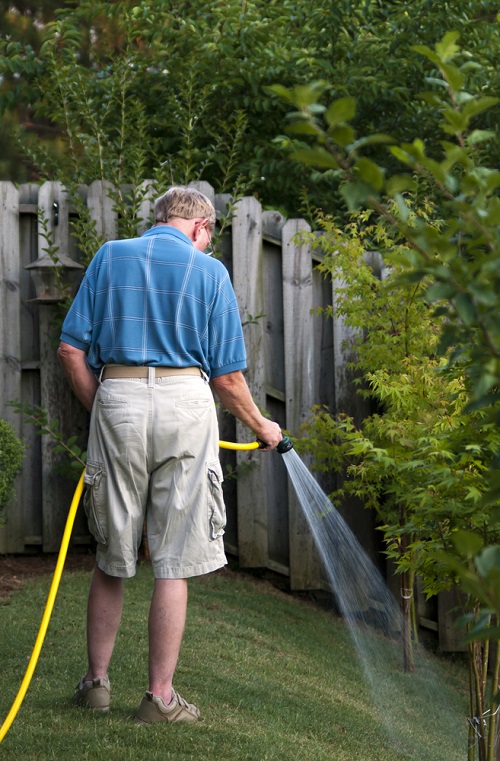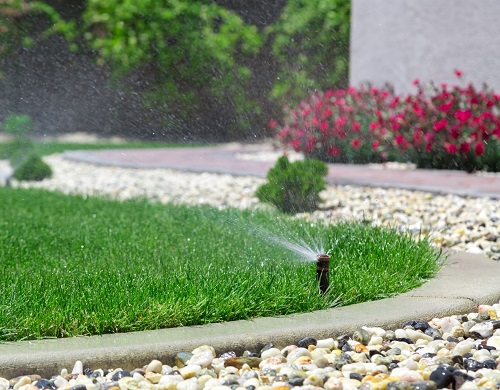Knowing about the Best Time to Water Lawn in Hot Weather can help in maintaining a lush green garden even in the hottest of summer!

Having a lush and green lawn can be a great source of pride for homeowners. However, maintaining a healthy patch of grass can be challenging, especially during hot weather conditions. We all know that one of the crucial aspects of lawn care is watering and knowing the best time to water your lawn during hot weather can create a significant difference in maintaining a great lawn.
Red How Often to Water Mint here
Best Time to Water Lawn in Hot Weather
The Best time to water lawns during hot weather is early morning, preferably between 4:00 a.m. to 10:00 a.m. During these hours, the temperature is cooler, and the wind is usually calmer, allowing the water to penetrate deep into the soil without evaporation.
Watering your lawn during these hours gives your grass enough time to dry before the sun is at its peak after 12. This helps to prevent fungal growth and diseases that thrive in moist environments.
Worst Time to Water Lawn in Hot Weather
The worst time to water your lawn during hot weather is in the afternoon, between 12:00 p.m. and 4:00 p.m. During this time, the sun is at its peak, and the temperature is high, causing rapid evaporation of water droplets from the soil surface before they can be absorbed by the grassroots.
You need to water your lawn for an extended period, which will require more water, leading to wastage. Watering during this time can also scorch your grass blades, causing it to turn brown and die.
Learn How to Water Seedlings Properly here
How Often to Water Lawn
The frequency of watering your lawn depends on several factors, including the type of grass, soil type, and weather conditions. As a general rule, it is recommended to water your lawn deeply once or twice a week during hot weather conditions. However, you should ensure that your lawn receives at least about 1 inch of water per week, which is enough for both warm and cool-season grasses. For cool-season grasses, you can water up to 1.5 inches a week, and the water penetrates deep into the soil to reach the root zone of the grass.
When watering your lawn, it is crucial to pay attention to the duration of watering. Typically, your lawn needs about 30 minutes to an hour of watering to ensure that the water penetrates deep into the soil.
Do You Water Aloe Vera from Top or Bottom? Know here
Signs of Overwatering

Overwatering your lawn can lead to several problems that affect the health and growth of your grass. Here are some of the signs of overwatering:
1. Yellowing Grass
It could be a sign of overwatering if you notice yellowing grass and a consistently moist or wet lawn. When your grass receives too much water, it can lead to a lack of oxygen in the soil, which affects the roots’ ability to absorb nutrients.
2. Mushrooms
Overwatering can create a damp and moist environment that promotes the growth of mushrooms in your lawn, especially in warm weather. Although most mushrooms are harmless, they can be unsightly and indicate that your lawn is receiving too much water; it can also be a sign of too much organic matter, which is a good sign.
Signs of Overwatering & How to Save an Overwatered Plant
3. Foul Odor
Overwatering can cause an unpleasant odor in your lawn due to the accumulation of stagnant water. This odor can be a sign of poor drainage and lack of water flow, which can lead to the death of your grass.
4. Increased Pest Activity
Overwatering can attract pests such as mosquitoes, gnats, and other insects that thrive in moist environments. These pests can damage your lawn and make it less healthy.
Conclusion
Watering your lawn is an essential aspect of maintaining a healthy and green lawn during hot weather conditions. Knowing how often to water your lawn and the signs of overwatering can ensure that your lawn remains healthy and vibrant.
Remember to water your lawn in the morning and avoid overwatering to prevent issues like root rot, fungal growth, and pest infestations. With the right care, your lawn can thrive even during the hottest weather conditions.
Learn the tips and tricks of how to water your plants when you are away here
FAQs
1. How Do I Determine if My Lawn Needs Watering?
Perform a “footprint test.” If the grass doesn’t spring back when you step on it, it’s time to water.
2. Can I Water My Lawn at Night During Hot Weather?
You should not water your lawn at night. Watering at night can promote fungal growth due to extended moisture on the grass.
3. Is It Better to Use a Sprinkler or a Drip Irrigation System for Lawn Watering in Hot Weather?
A drip irrigation system is more efficient, as it delivers water directly to the roots, minimizing water loss to evaporation.
How To Water Plants + 5 Watering Mistakes You’re Doing
4. Best Time of Day to Water Lawn in Hot Weather
The best time to water your lawn in hot weather is early in the morning, preferably between 4:00 a.m. and 10:00 a.m. This allows the grass to absorb moisture before the sun becomes too intense, reducing water loss to evaporation and promoting healthier grass growth.
5. Should I Mow My Lawn Before or After Watering It in Hot Weather?
Mow your lawn before watering. Mowing after can stress the grass, especially in high temperatures.
6. What’s the Ideal Depth for Water Penetration When Watering My Lawn in Hot Weather?
You should aim for about 6-8 inches of water penetration to encourage deep root growth. You can poke a stick or screwdriver to find out the water penetration level.



